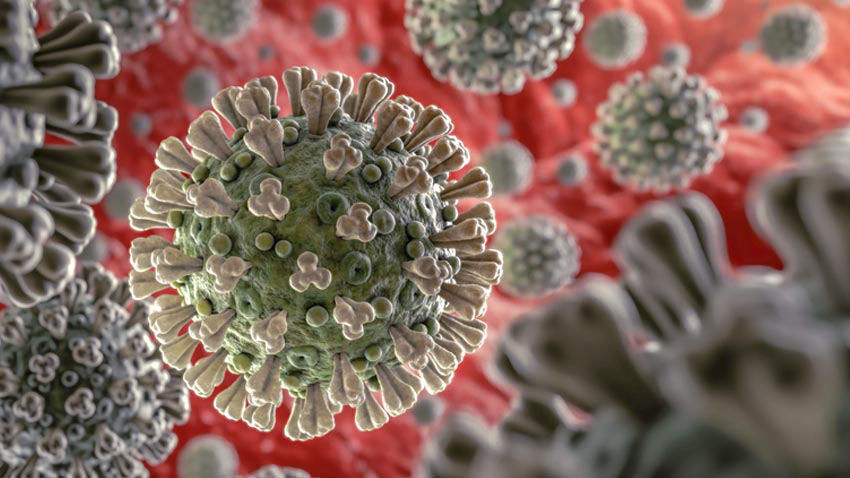Indicators of COVID-19 community spread manifesting in Teche Area
Published 2:51 pm Wednesday, November 18, 2020

- Christmasy COVID
The surge in positive COVID-19 cases seen nationwide has begun to manifest itself in Louisiana, especially in the Acadiana area, where the seven-day test positivity rate has crossed the 10 percent threshold set as the baseline for community spread in a region.
Trending
According to Wednesday’s update from the Louisiana Department of Health, the state’s seven-day average of tests given as of Nov. 11 was 239.3 tests per 10,000 residents. The positivity rate among those tests was 7.5 percent.
But in Region 4, the Nov. 11 numbers were even worse. The testing rate in the region was marginally above the state average, at 242.7 tests per 10,000 residents. The seven-day average percent positive of those tests, however, was well above the state average at 10.3 percent.
In Iberia Parish, the number of cases was at 3,405 Wednesday, an increase of 13. Of those, 3,332 are confirmed, with 73 probable. The number of deaths remained at 103, 100 confirmed and three probable, with 40,961 tests performed in the parish.
Trending
The seven-day positivity rates among test results in Iberia Parish zoomed more than 145 percent from Nov. 4 to Nov. 11. The Nov. 11 figure shows the parish with an 11.3 percent positivity rate, up from 4.6 percent on Nov. 4. The LDH latest two-week incidence map update showed that the parish’s positive test also rose, from 53.57 cases reported per 100,000 population on Oct. 21 to 77.53 per 100,000 on Nov. 4.
St. Martin Parish’s number of identified cases rose to 2,513, an increase of 17, with 34,805 tests performed. The seven-day average of positive tests in that parish rose by 22.4 percent, from 9.8 percent on Nov. 4 to 12 percent on Nov. 11. The LDH two-week incidence map shows that on Oct. 21, St. Martin Parish had 124.95 cases reported per 100,000 population As of Nov. 4, that number rose to 173.44 cases per 100,000 population. The number of deaths remained at 70, 65 confirmed and five probable.
In St. Mary Parish, total cases rose to 2,247, an increase of eight, after 25,562 tests. Of those, 2,169 are confirmed, with 78 probable. The number of COVID-19 deaths remained at 94, with 89 confirmed and four probable.
The seven-day positivity rate for tests in the parish rose by more than 141 percent, from 4.6 percent on Nov. 4 to 8.7 percent on Nov. 11. The LDH two-week incidence map shows the parish at 100.45 positive tests per 100,000 population on Nov. 11, up from 60.27 cases reported per 100,000 population on Oct. 21.
In Lafayette Parish, the Wednesday case count rose to 10,782, an increase of 102, with the number of tests rising to 170,575. The number of deaths was at 143, with 142 confirmed and one probable. The seven-day average of positive tests rose almost 115 percent, from 4.7 per 10,000 population on Nov. 4 to 10.10 per 10,000 on Nov. 11. The LDH two-week incidence map shows that the parish had 115.33 cases per 100,000 population on Nov. 4, up from 101.33 cases reported per 100,000 population on Oct. 21.
The number of cases in Jefferson Parish rose to 20,543 on Wednesday, up by 186 cases, compared to 14,711 in Orleans Parish. The latest data shows Orleans administered more tests, with 378,911 in Orleans compared to 287,483 tests in Jefferson.
Despite lower case numbers, the more urban Orleans Parish has seen nine more confirmed deaths than its suburban neighbor. Orleans Parish deaths were at 644, with 605 confirmed and 39 probable. In Jefferson Parish, the total number of deaths was at 622, with 597 confirmed and 25 probable.
In Jefferson Parish, the seven-day test positivity rate climbed to 5.1 percent as of Nov. 11, up from 4.1 percent on Nov. 4, compared to a climb from 1.6 percent to 2.5 percent over the same period in Orleans Parish. The LDH two-week incidence map shows that on Nov. 4, Jefferson Parish had 122.11 cases per 100,000 population, down from 127.87 cases reported per 100,000 population on Oct. 21. The two-week incidence per 100,000 was at 100 per 100,000 population in Orleans Parish on Nov. 4, down from 107.42 per 100,000 on Oct. 21.
Wednesday’s daily COVID-19 data showed the state adding 2,239 new cases, raising the total identified infections so far in the state to 209,914. Of those, 200,982 are confirmed, with 8,932 probable.
The state added 22,771 new test results Wednesday, making the rough positivity rate for that day’s tests 9.8 percent.
According to the Wednesday update, the number of deaths attributed to COVID-19 rose to 6,184, an increase of 28 from 6,156 on Tuesday. Of those, 5,939 are confirmed, with 245 considered probable COVID-19 fatalities pending final testing.
That rise represents an increase of 0.45 percent. The average age of fatal patients is 75, the median age 76.
The LDH reporting of data on hospitalizations due to the disease usually runs 24 hours behind its testing data. On Wednesday, the state reported 886 hospitalizations as of Tuesday, an increase of 12 from 874 on Monday. The number of patients on ventilators rose by one, to 93 Tuesday. That is up from 92 on Monday.
The number of COVID-19 hospitalizations in Region 4, which covers Acadiana, rose by five to 101 on Tuesday, up from 96 on Monday. The number of patients on ventilators Tuesday dropped to 11, down by three from 14 on Monday.
The overall intensive care bed occupancy rate in Region 4 surged to 92.4 percent Tuesday, with 145 beds occupied and 12 ICU beds still available. The total number of ICU beds available was at 157.
Tuesday’s data showed that hospital bed occupancy in Region 4 was also on the rise, at 80.9 percent, with 1,263 of the region’s beds occupied and 299 available. The total number of reported beds was at 1,562.
When compared by age group, the number of cases in the 18 to 29 demographic was at 46,506 Wednesday. It is the demographic group with the largest number of identified cases by far. The number of deaths reported in the group remained at 26.
The number of COVID-19 cases identified in the 30 to 39 age group was at 33,395, with 88 deaths, followed closely by the 40 to 49 age group, with 30,874 cases and 198 deaths, and the 50 to 59 age range with 30,058 cases, including 527 fatalities reported.
In the 60 to 69 age group, there were 23,680 cases reported and 1,126 deaths. This age group has the second-highest number of deaths, behind only the 70 and above demographic group.
The 70 and above group case count was at 23,255. The number of deaths in that group rose to 4,213 — still the largest number of fatalities for any age group by far, more than the number of deaths in all other groups combined and more than two-thirds of the total COVID-19 attributed deaths in the state.
The under 18 group, the smallest demographic segment, had 21,932 cases total — 4,203 age 4 and under — and six reported deaths.
According to Wednesday’s update, labs in Louisiana have processed at least 3,156,670 COVID-19 tests so far.
The state has also started tracking possible cases, which is the number of individuals with a positive test detecting SARS-CoV-2 antigens. That number was 8,932 as of Nov. 11. According to an LDH spokesman, individuals initially identified as having a positive antigen test who are later identified as having a positive confirmatory test will be removed from the probable case count and added to the cumulative case count.
By gender, the state’s daily report shows women making up the largest part — 55 percent — of the identified COVID-19 cases in the state, with men comprising 44 percent and 1 percent unknown. On the other hand, the COVID-19 deaths are predominantly among men, 52 percent to 48 percent for women.
The number of presumed recovered cases, as of Nov. 9, rose to 185,960. In order to be considered recovered, a living patient must either be out of the hospital and 14 days past a positive test result, or 21 days past a positive test date if their hospitalization status is unknown.
On Nov. 4, the weekly update of fatalities by race showed the percentage of COVID-19 deaths among White victims continued to climb. Initially, LDH reported that 70 percent of all COVID-19 deaths in the state were in the Black community. That number has since dropped to 44 percent as of Nov. 11, while White victims now make up 54.66 percent of all fatal cases.
The Native American/Alaskan Native total was at 0.11 percent. Native Hawaiian/Pacific Islander data remained at 0.08 percent. Other races identified include Asian at 0.67 percent, and Other at 0.44 percent.
That data is only reported once a week, updated on Wednesday.
The top three underlying conditions among COVID-19 deaths in the latest report were hypertension (50.35 percent), diabetes (29.06 percent), and neurological disorders (21.57 percent).
Other factors included cardiac disease (20.64 percent), chronic kidney disease (17.53 percent), obesity (16.02 percent), congestive heart failure (13.07 percent), pulmonary issues (11.26 percent), cancer (6.76 percent), and asthma (3.34 percent). Only 4.3 percent of all fatalities had no underlying conditions.





